#snub cuboctahedron
Explore tagged Tumblr posts
Text
Polytope info card of the Snub Cube
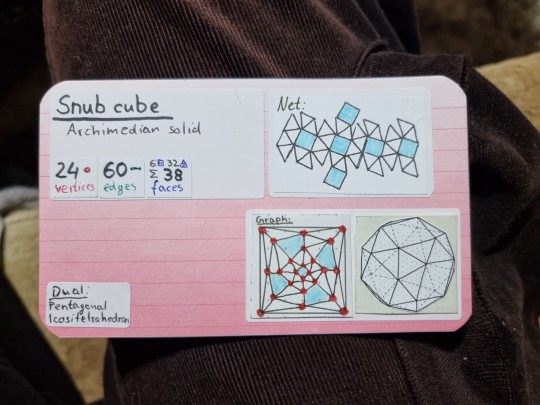
Today's shape was the archimedian solid "Snub cube".
The snub cube has 38 faces in total - 6 square faces and 32 triangular faces.
It has 60 edges and 24 vertices.
Each vertex is met by 4 triangle faces and 1 square face.
A snub cube is an alteration of a truncated cuboctahedron.
The drawing:
For the isometric projection drawing I started with a truncated cuboctahedron, and continued to alter the truncated cuboctahedron's octagonal faces into square faces.
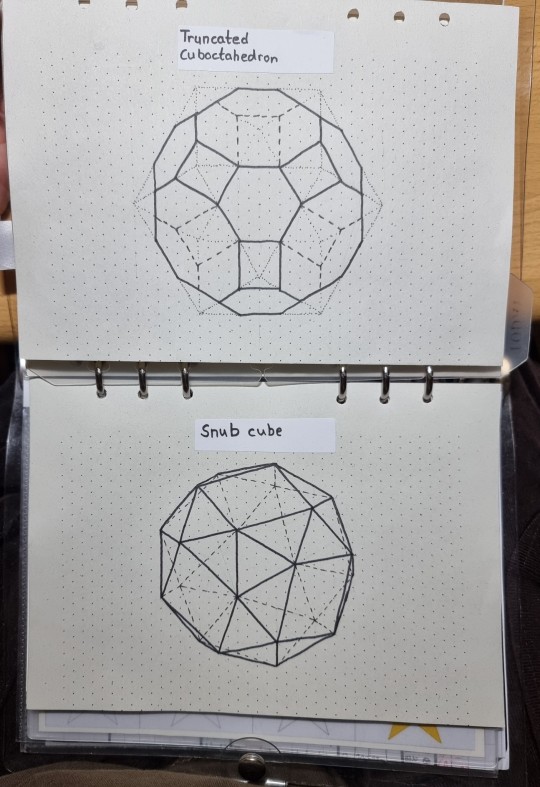
#polyhedra#polytope info cards#polytope#polytopes#polyhedron#archimedian solids#archimedian solid#snub cube#snub cuboctahedron#truncated cuboctahedron#cuboctahedron#truncation#mathy stuffy#math stuff#math#knottys math#knottys mathy stuffy#mathematics#math joy#math passion#geometry#geometric drawing#shapes
36 notes
·
View notes
Text
Regular-ish Convex Polyhedra Bracket — Round 5 (Third Place)

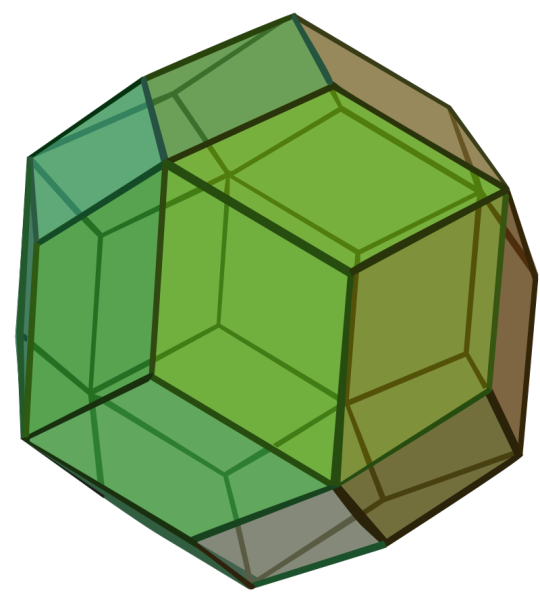
Propaganda
Snub Cube:
Also called the Snub Cuboctahedron
Archimedean Solid
Semiregular
Dual of the Pentagonal Icositetrahedron
It has 6 square faces, 32 regular triangular faces, 60 edges, and 24 vertices.
Chiral so it has two forms that are mirror images of each other.
Image Credit: Cyp
Rhombic Triacontahedron:
Also called the Triacontahedron
Catalan Solid
Dual of a quasiregular polyhedron
Dual of the Icosidodecahedron
It has 30 rhombic faces, 62 edges, and 32 vertices of two types.
One of the 9 edge-transitive convex polyhedra along with the 5 Platonic Solids, the 2 Quasiregular Convex Polyhedra, and the Rhombic Dodecahedron.
It has both the tumbling block quilt pattern and a five-pointed star on its surface.
Image Credit: Maxim Razin based on Cyp
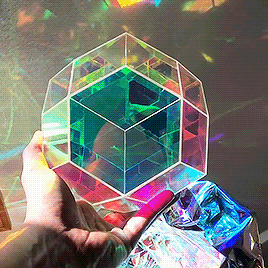
#Round 5#Snub Cube#Snub Cuboctahedron#Rhombic Triacontahedron#Archimedean Solids#Catalan Solids#Polyhedra
27 notes
·
View notes
Text
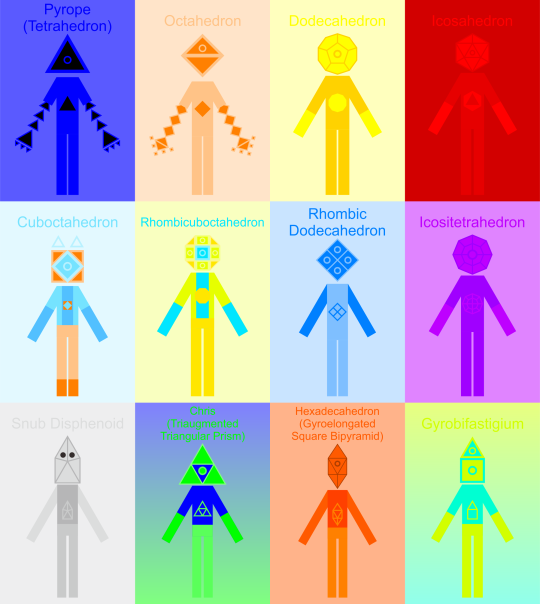
A Chart of my Polyhedra JSAB OC's
#jsab#just shapes and beats#jsab oc#Pyrope#Tetrahedron#Octahedron#Dodecahedron#Icosahedron#Cuboctahedron#Rhombicuboctahedron#Rhombic Dodecahedron#Deltoidal Icositetrahedron#Snub Disphenoid#Triaugmented Triangular Prism#Gyroelongated Square Bipyramid#Gyrobifastigium
5 notes
·
View notes
Text
day 1550 of pretending snapcube doesn't exist
0 notes
Text
Polyhedron of the Day #171: Compound of two snub cubes
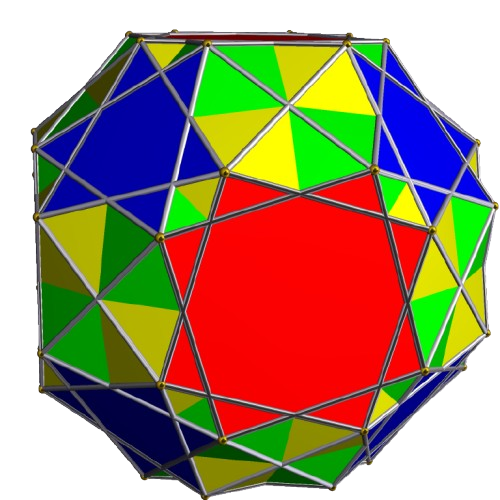
The compound of two snub cubes is a uniform polyhedral compound. It has 76 faces, 120 edges, and 48 vertices. It is also known as the disnub cuboctahedron. Its Bowers-style acronym is disco. Its Schläfli symbol is βr{4,3}. It is constructed by composing the two mirror image forms of the snub cube. It shares its vertex arrangement with a convex nonuniform truncated cuboctahedron. Its vertex figure is a mirror symetric pentagon. Its dual is the compound of two pentagonal icositetrahedra.
Image created using Robert Webb's Stella software, found at http://www.software3d.com/Stella.php.
19 notes
·
View notes
Text
Drawing a snub dodecahedron (in isometric perspective) is quite lot of work, because I have to start with a dodecahedron (easy), then make an isocidodecahedron out of it (quite a lot of work) , and then make a truncated icosidodecahedron out of it (very much work) and then, after all these steps I can make the snub dodecahedron from this.
It is a similar procedure I used for drawing the snub cube:
Started with cube, then cuboctahedron, then truncated cuboctahedron, then snub cube.
7 notes
·
View notes
Text



Oh snub cube/snub cuboctahedron, I know you're just a shape, but I love you so much.
This is a snub cube appreciation post. No snub cube hate is allowed here.
0 notes
Text

This model was designed by Alex Doskey using Great Stella. It was then exported to VRML format, which was used to build the physical model in a ZCorp stereolithograph machine. The model is only about 6 inches across, and has all regular non-intersecting faces.
Models by Adam Stolicki
Models by Adam Stolicki
Model by Adam Stolicki Model by Adam Stolicki Models by Adam Stolicki
Model by Adam Stolicki Model by Adam Stolicki Models by Adam Stolicki
Models by Giacomo Artoni
Hollow spherical model Stellation of Small Icosihemidodecahedron Stellation of Snub Cube Stellation of Great Dodecahemidodecahedron
Hollow spherical model
designed using this tutorial Compound of 6 Dodecahedra Stellation of Small Stellated
Truncated Dodecahedron Compound of 5 Octahedra
Models by Richard Stratton
Stellation of Great Ditrigonal Dodecicosidodecahedron Stellation of Small Icosihemidodecahedron Stellation of Snub Cube Stellation of Great Dodecahemidodecahedron
Stellation of Great Ditrigonal
Dodecicosidodecahedron Stellation of Small
Icosihemidodecahedron Stellation of Snub Cube Stellation of Great
Dodecahemidodecahedron
Models by Marc Picquendar
Stellation of Rhombic Triacontahedron Stellation of Rhombic Triacontahedron Small Snub Icosicosidodecahedron
Stellation of Rhombic Triacontahedron Final Stellation of Rhombic
Triacontahedron Small Snub
Icosicosidodecahedron
Compound of 5 Cubes Stellation of Truncated Octahedron Pentagonal Hexecontahedron Pentagonal Icositetrahedron
Compound of 5 Cubes Stellation of Truncated
Octahedron Pentagonal
Hexecontahedron Pentagonal
Icositetrahedron
Models by Robert Rech
Stellation of Great Ditrigonal Dodecicosidodecahedron Stellation of Small Icosihemidodecahedron
Stellation of Strombic Icositetrahedron Stellation of Triakisoctahedron
Models by Linda Zurich
Stellation of Cubitruncated Cuboctahedron Another stellation Stellation of Icosahedron Another stellation
Stellation of Cubitruncated
Cuboctahedron Another stellation Stellation of Icosahedron Another stellation
Models by Karlos Alonso Mediavilla
Compound of 5 Tetrahedra Compound of 3 Cubes Faceted Cube Compound of Dodecahedron and Great Dodecahedron
Compound of 5 Tetrahedra Compound of 3 Cubes Faceted Cube Compound of Dodecahedron
and Great Dodecahedron
Models by Steve Waterman
Waterman polyhedra
The first ten Waterman polyhedra in each of the three types available in Great Stella.
Models by Michael Barltrop
Compound of 15 Cuboids Compound of 4 Cubes Stellation of the Small Dodecahemicosahedron
Compound of 15 Cuboids Compound of 4 Cubes Stellation of the Small Dodecahemicosahedron
Monoacral stellation of Compound of 15 Cuboids Stellation of Small Dodecahemicosahedron Stellation of Great Dodecahemicosahedron
Monoacral stellation of
Compound of 15 Cuboids Stellation of Small Dodecahemicosahedron Stellation of Great Dodecahemicosahedron
A stellation Stellation of Small Stellated Truncated Dodecahedron
Stellation of the first Faceted
Rhombicosidodecahedron found in
Stella's Library Stellation of Small Stellated
Truncated Dodecahedron
Models by Keith Davison
See also: What people have to say about Stella.
0 notes
Text

A Snub disphenoid, Cuboctahedron, Enneagonal Prism, and a Disdyakis Triacontahedron!
Learning shapes and their names was for kindergarten omg. I didn’t realize people went ahead and named every possible shape they could think of. More coming.
#ohheyisaidthat#funshapes#if the links every break: they just link to the wikipedia page for the shape! which is where the photos are from.
0 notes
Text
In a kite-rhombus solid, or KRS, all faces are either kites or rhombi, and there are at least some of both of these quadrilateral-types as faces. I have found eight such polyhedra, all of which are formed by creating the convex hull of different Archimedean-Catalan base-dual compounds. Not all Archimedean-Catalan compounds produce kite-rhombus solids, but one of the eight that does is derived from the truncated dodecahedron, as explained below.

The next step is to create the compound of this solid and its dual, the triakis icosahedron. In the image below, this dual is the blue polyhedron.

The convex hull of this compound, below, I’m simply calling “the KRS derived from the truncated dodecahedron,” until and unless someone invents a better name for it.
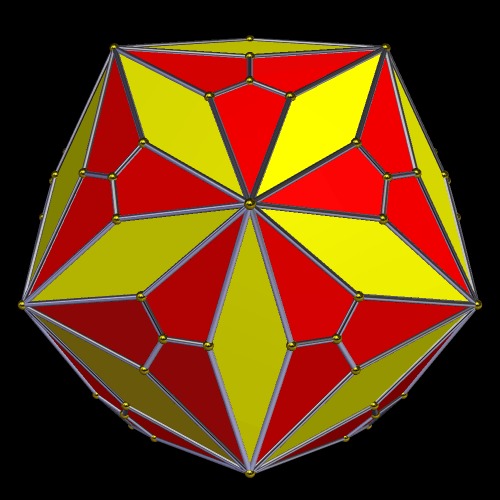
The next KRS shown is derived, in the same manner, from the truncated tetrahedron.
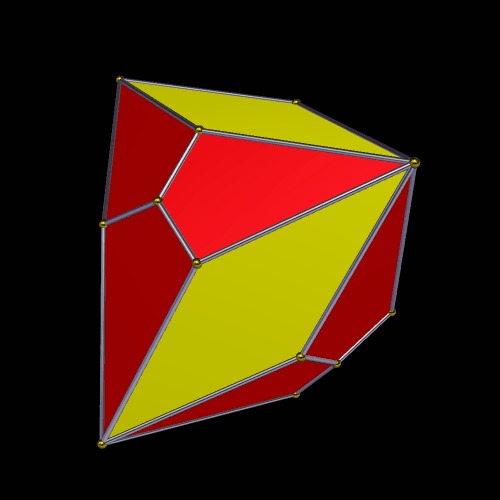
Here is the KRS derived from the truncated cube.

The truncated icosahedron is the “seed” from which the next KRS shown is derived. This KRS is a “stretched” form of a zonohedron called the rhombic enneacontahedron.

Another of these kite-rhombus solids, shown below, is based on the truncated octahedron.
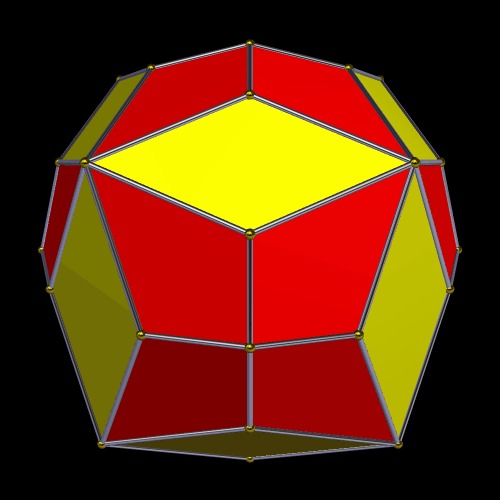
The next KRS shown is based on the rhombcuboctahedron.

Two of the Archimedeans are chiral, and they both produce chiral kite-rhombus solids. This one is derived from the snub cube.
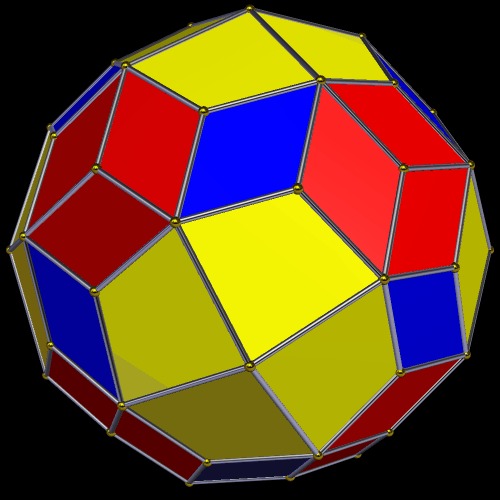
Finally, to complete this set of eight, here is the KRS based on the snub dodecahedron.

You may be wondering what happens when this same process is applied to the other five Archimedean solids. The answer is that all-kite polyhedra are produced; they have no rhombic faces. Two are “stretched” forms of Catalan solids, and are derived from the cuboctahedron and the icosidodecahedron:
If this procedure is applied to the rhombicosidodecahedron, the result is an all-kite polyhedron with two different face-types, as seen below.
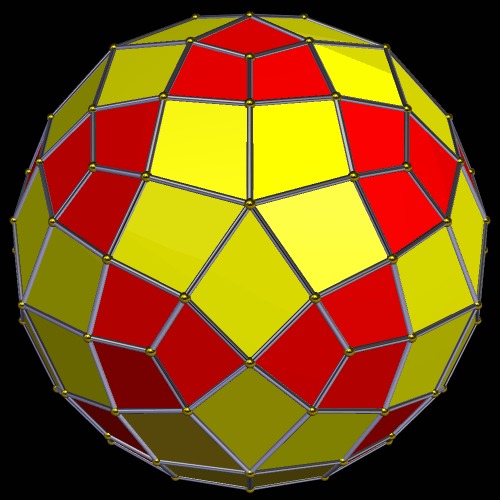
The two remaining Archimedean solids are the great rhombcuboctahedron and the great rhombicosidodecahedron, each of which produces a polyhedron with three different types of kites as faces.
The polyhedron-manipulation and image-production for this post was performed using Stella 4d: Polyhedron Navigator, which may be purchased or tried for free at http://www.software3d.com/Stella.php.
Eight Kite-Rhombus Solids, Plus Five All-Kite Polyhedra — the Convex Hulls of the Thirteen Archimedean-Catalan Compounds In a kite-rhombus solid, or KRS, all faces are either kites or rhombi, and there are at least some of both of these quadrilateral-types as faces.
#Archimedean#Catalan#convex hull#dual#duality#geometry#kite#Mathematics#polyehdron#polyhedra#rhombi#rhombus#solid
2 notes
·
View notes
Text
Regular-ish Convex Polyhedra Bracket — Round 1


Propaganda
Truncated Octahedron:
Archimedean Solid
Semiregular
Dual of the Tetrakis Hexahedron
It has 8 regular hexagonal faces, 6 square faces, 36 edges, and 24 vertices.
A space-filling tessellation/honeycomb of Euclidean three-space.
Image Credit: Cyp
Snub Cube:
Also called the Snub Cuboctahedron
Archimedean Solid
Semiregular
Dual of the Pentagonal Icositetrahedron
It has 6 square faces, 32 regular triangular faces, 60 edges, and 24 vertices.
Chiral so it has two forms that are mirror images of each other.
Image Credit: Cyp
24 notes
·
View notes
Text
Regular-ish Convex Polyhedra Bracket — Round 2


Propaganda
Sphere:
"Formally, a sphere is the set of points that are all at the same distance r from a given point in three-dimensional space." — Wikipedia
Not a convex polyhedron.
Image Credit: Tumblr
Snub Cube:
Also called the Snub Cuboctahedron
Archimedean Solid
Semiregular
Dual of the Pentagonal Icositetrahedron
It has 6 square faces, 32 regular triangular faces, 60 edges, and 24 vertices.
Chiral so it has two forms that are mirror images of each other.
Image Credit: Cyp
25 notes
·
View notes
Text
Regular-ish Convex Polyhedra Bracket — Round 4


Propaganda
Snub Cube:
Also called the Snub Cuboctahedron
Archimedean Solid
Semiregular
Dual of the Pentagonal Icositetrahedron
It has 6 square faces, 32 regular triangular faces, 60 edges, and 24 vertices.
Chiral so it has two forms that are mirror images of each other.
Image Credit: Cyp
Truncated Icosidodecahedron:
Also called the Rhombitruncated Icosidodecahedron, Great Rhombicosidodecahedron, Omnitruncated Dodecahedron, Omnituncated Icosahedron
Archimedean Solid
Semiregular
Dual of the Disdyakis Triacontahedron
It has 12 regular decagonal faces, 20 regular hexagonal faces, 30 square faces, 180 edges, and 120 vertices.
It has the most edges and vertices of all platonic and archimedean solids.
Of the vertex-transitive polyhedra, it fills up the most of the volume of the sphere it fits in (89.80%).
It is not actually the shape you get when you truncate an icosidodecahedron, although it is topologically equivalent.
It is the mod's favorite three-dimensional shape.
They made a void truncated icosidodecahedron and it's glorious. I had one for a while, it's hard to turn because of alignment issues, especially the decagonal sides. Fun puzzle tho, never did figure out how to permute the last layer...
Image Credit: @anonymous-leemur

#Round 4#Snub Cube#Snub Cuboctahedron#Truncated Icosidodecahedron#Great Rhombicosidodecahedron#Polyhedra#Archimedean Solids
13 notes
·
View notes
Text
Regular-ish Convex Polyhedra Bracket — Round 3


Propaganda
Snub Cube:
Also called the Snub Cuboctahedron
Archimedean Solid
Semiregular
Dual of the Pentagonal Icositetrahedron
It has 6 square faces, 32 regular triangular faces, 60 edges, and 24 vertices.
Chiral so it has two forms that are mirror images of each other.
Image Credit: Cyp
Icosidodecahedron:
Archimedean Solid
Quasiregular
Dual of the Rhombic Triacontahedron
It has 12 regular pentagonal faces, 20 regular trianglar faces, 60 edges, and 30 vertices.
Vertex Transitive AND Edge Transitive
Image Credit: Cyp
9 notes
·
View notes
Text
Daily Polyhedra Archive
(An ongoing list of polyhedra that have already been covered by this blog, mostly for my own convenience. This is a work-in-progress.)
Platonic solids
Cube
Dodecahedron
Icosahedron
Octahedron
Tetrahedron
Kepler-Poinsot polyhedra
Great dodecahedron
Great icosahedron
Great stellated dodecahedron
Small stellated dodecahedron
Archimedean solids
Cuboctahedron
Great rhombicuboctahedron
Icosidodecahedron
Rhombicosidodecahedron
Small rhombicuboctahedron
Snub cube
Snub dodecahedron
Truncated cube
Truncated dodecahedron
Truncated icosahedron
Truncated icosidodecahedron
Truncated octahedron
Truncated tetrahedron
Catalan solids
Deltoidal hexecontahedron
Deltoidal icositetrahedron
Disdyakis dodecahedron
Disdyakis triacontahedron
Pentagonal hexecontahedron
Pentagonal icositetrahedron
Pentakis dodecahedron
Rhombic dodecahedron
Rhombic triacontahedron
Tetrakis hexahedron
Triakis icosahedron
Triakis octahedron
Triakis tetrahedron
Prismatic polyhedra
Triangular prism
Pentagonal prism
Schönhardt polyhedron
Decagrammic antiprism
Square antiprism
Pyramidal polyhedra
Square pyramid
Hexagonal pyramid
Johnson solids
Square pyramid (J1)
Triangular bipyramid (J12)
Gyroelongated pentagonal rotunda (J25)
Square orthobicupola (J28)
Pentagonal orthobicupola (J30)
Elongated pentagonal gyrobicupola (J39)
Gyroelongated pentagonal cupolarotunda (J47)
Gyroelongated pentagonal birotunda (J48)
Triaugmented hexagonal prism (J57)
Augmented tridiminished icosahedron (J64)
Biaugmented truncated cube (J67)
Gyrate rhombicosidodecahedron (J72)
Snub disphenoid (J84)
Sphenomegacorona (J88)
Hebesphenomegacorona (J89)
Disphenocingulum (J90)
Bilunabirotunda (J91)
Triangular hebesphenorotunda (J92)
Near-miss Johnson solids
Edge-contracted icosahedron
Tetrated dodecahedron
Truncated triakis tetrahedron
Pentahexagonal pyritoheptacontatetrahedron
Rectified truncated icosahedron
Chamfered cube
Chamfered dodecahedron
Hemipolyhedra
Small dodecahemicosahedron
Tetrahemihexacron
Small icosihemidodecahedron
Zonohedra
Rhombic enneacontahedron
Bilinski dodecahedron
Truncated rhombicosidodecahedron
Rhombic icosahedron
Star polyhedra
Small snub icosidodecahedron
Rhombicosahedron
Great snub icosidodecahedron
Inverted snub dodecadodecahedron
Excavated dodecahedron
Great rhombic triacontahedron
Great triakis icosahedron
Great dirhombicosidodecahedron
Cubitruncated cuboctahedron
Quasitruncated great stellated dodecahedron
Uncategorised polyhedra
Chamfered icosahedron
Triamond stretched octahedron
Diminished rhombic dodecahedron
Császár polyhedron
Szilassi polyhedron
Biscribed orthotruncated propello octahedron
Rectified triangular prism
Escher's solid
Polyhedral compounds
Compound of five cubohemioctahedra
Compound of twenty octahedra
Compound of four cubes
Compound of two icosahedra
Compound of two great retrosnub icosidodecahedra
Compound of eight octahedra
Rhomboctahedron (compound of four triangular prisms)
Compound of five tetrahedra
10 notes
·
View notes
